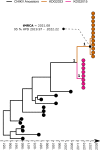Genomic characterization of a reemerging Chikungunya outbreak in Kedougou, Southeastern Senegal, 2023
- PMID: 38934257
- PMCID: PMC11268258
- DOI: 10.1080/22221751.2024.2373308
Genomic characterization of a reemerging Chikungunya outbreak in Kedougou, Southeastern Senegal, 2023
Abstract
Chikungunya virus has caused millions of cases worldwide over the past 20 years, with recent outbreaks in Kedougou region in the southeastern Senegal, West Africa. Genomic characterization highlights that an ongoing epidemic in Kedougou in 2023 is not due to an introduction event but caused by the re-emergence of an endemic strain evolving linearly in a sylvatic context.
Keywords: Chikungunya; Kedougou; Southeastern Senegal; genomic characterization; outbreak.
Conflict of interest statement
No potential conflict of interest was reported by the author(s).
Figures


References
Publication types
MeSH terms
Grants and funding
LinkOut - more resources
Full Text Sources
Other Literature Sources
Medical
Miscellaneous
